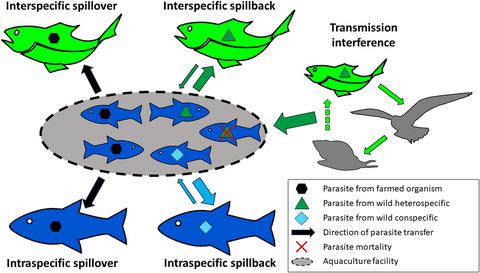当前位置:
X-MOL 学术
›
J. Appl. Ecol.
›
论文详情
Our official English website, www.x-mol.net, welcomes your
feedback! (Note: you will need to create a separate account there.)
Collateral diseases: aquaculture impacts on wildlife infections
Journal of Applied Ecology ( IF 5.0 ) Pub Date : 2020-10-26 , DOI: 10.1111/1365-2664.13775 Mark M. Bouwmeester 1 , M. Anouk Goedknegt 2 , Robert Poulin 3 , David W. Thieltges 1
Journal of Applied Ecology ( IF 5.0 ) Pub Date : 2020-10-26 , DOI: 10.1111/1365-2664.13775 Mark M. Bouwmeester 1 , M. Anouk Goedknegt 2 , Robert Poulin 3 , David W. Thieltges 1
Affiliation

|
1. Aquaculture is a promising source of fish and other aquatic organisms to ensure human food security but it comes at the price of diverse environmental impacts. Among others, these include diseases which often thrive under the conditions in aquaculture settings and can cause high economic losses. These diseases may also affect wildlife, however, the impacts of aquaculture on disease dynamics in wild species in surrounding ecosystems are poorly understood.2. In this Review, we provide a conceptual framework for studying the effects of aquaculture on wildlife diseases, and illustrate the different mechanisms identified with examples from the literature. In addition, we highlight further research needs and recommendations for management and policy.3. We identified five potential means by which farmed populations may alter wildlife disease dynamics: i) farmed species may co‐introduce parasites to the new environment, which infect wild conspecifics without infecting other species (intraspecific parasite spillover); ii) these co‐introduced parasites from farmed species may infect other wild host species potentially leading to emerging diseases (interspecific parasite spillover); iii) parasites from other wild host species may infect farmed species, amplifying parasite numbers and increasing parasite infections when spilling back to wild hosts (interspecific parasite spillback); iv) farmed species may acquire parasites from wild conspecifics, increasing parasite population size and subsequently raising infection loads in the wild host population (intraspecific parasite spillback); and v) farmed species may be neither host nor parasite, but affect the transmission of parasites between wild host species (transmission interference). Although these mechanisms can alter wildlife disease dynamics, we found large knowledge gaps regarding collateral disease impacts and strong biases in terms of production countries, aquaculture practices and host taxa.4. Synthesis and applications. The strong potential for aquaculture to affect the dynamics of diseases in wildlife populations calls for the consideration of collateral disease impacts in risk assessments and biosecurity protocols regarding aquaculture. In particular, comprehensive parasite inventories of both farmed and wild hosts as well as disease monitoring in wildlife surrounding farms will be necessary to increase our knowledge on aquaculture impacts on wildlife disease and to develop adequate prevention and mitigation measures.
中文翻译:

附带疾病:水产养殖对野生动物感染的影响
1. 水产养殖是确保人类粮食安全的鱼类和其他水生生物的有前途的来源,但其代价是对环境的影响多种多样。其中包括在水产养殖条件下经常滋生的疾病,并可能造成高昂的经济损失。这些疾病也可能影响野生动物,然而,人们对水产养殖对周围生态系统中野生物种疾病动态的影响知之甚少。2。在这篇综述中,我们提供了一个研究水产养殖对野生动物疾病影响的概念框架,并通过文献中的例子说明了不同的机制。此外,我们强调进一步的研究需求和管理和政策的建议。3。我们确定了养殖种群可能改变野生动物疾病动态的五种潜在方式:i) 养殖物种可能会将寄生虫共同引入新环境,从而感染野生同类而不感染其他物种(种内寄生虫外溢);ii) 这些来自养殖物种的共同引入的寄生虫可能会感染其他野生宿主物种,从而可能导致新出现的疾病(种间寄生虫外溢);iii) 来自其他野生宿主物种的寄生虫可能会感染养殖物种,当溢出回野生宿主时会增加寄生虫数量并增加寄生虫感染(种间寄生虫溢出);iv) 养殖物种可能从野生同种获得寄生虫,从而增加寄生虫种群规模并随后增加野生宿主种群的感染负荷(种内寄生虫溢出);v) 养殖物种可能既不是宿主也不是寄生虫,但影响寄生虫在野生宿主物种之间的传播(传播干扰)。尽管这些机制可以改变野生动物疾病动态,但我们发现在附带疾病影响方面存在巨大的知识差距,并且在生产国、水产养殖实践和宿主分类群方面存在严重偏见。4。合成与应用。水产养殖影响野生动物种群疾病动态的巨大潜力要求在有关水产养殖的风险评估和生物安全协议中考虑附带疾病的影响。特别是养殖和野生宿主的综合寄生虫清查以及农场周围野生动物的疾病监测对于增加我们对水产养殖对野生动物疾病影响的了解以及制定适当的预防和缓解措施是必要的。
更新日期:2020-10-26
中文翻译:

附带疾病:水产养殖对野生动物感染的影响
1. 水产养殖是确保人类粮食安全的鱼类和其他水生生物的有前途的来源,但其代价是对环境的影响多种多样。其中包括在水产养殖条件下经常滋生的疾病,并可能造成高昂的经济损失。这些疾病也可能影响野生动物,然而,人们对水产养殖对周围生态系统中野生物种疾病动态的影响知之甚少。2。在这篇综述中,我们提供了一个研究水产养殖对野生动物疾病影响的概念框架,并通过文献中的例子说明了不同的机制。此外,我们强调进一步的研究需求和管理和政策的建议。3。我们确定了养殖种群可能改变野生动物疾病动态的五种潜在方式:i) 养殖物种可能会将寄生虫共同引入新环境,从而感染野生同类而不感染其他物种(种内寄生虫外溢);ii) 这些来自养殖物种的共同引入的寄生虫可能会感染其他野生宿主物种,从而可能导致新出现的疾病(种间寄生虫外溢);iii) 来自其他野生宿主物种的寄生虫可能会感染养殖物种,当溢出回野生宿主时会增加寄生虫数量并增加寄生虫感染(种间寄生虫溢出);iv) 养殖物种可能从野生同种获得寄生虫,从而增加寄生虫种群规模并随后增加野生宿主种群的感染负荷(种内寄生虫溢出);v) 养殖物种可能既不是宿主也不是寄生虫,但影响寄生虫在野生宿主物种之间的传播(传播干扰)。尽管这些机制可以改变野生动物疾病动态,但我们发现在附带疾病影响方面存在巨大的知识差距,并且在生产国、水产养殖实践和宿主分类群方面存在严重偏见。4。合成与应用。水产养殖影响野生动物种群疾病动态的巨大潜力要求在有关水产养殖的风险评估和生物安全协议中考虑附带疾病的影响。特别是养殖和野生宿主的综合寄生虫清查以及农场周围野生动物的疾病监测对于增加我们对水产养殖对野生动物疾病影响的了解以及制定适当的预防和缓解措施是必要的。











































 京公网安备 11010802027423号
京公网安备 11010802027423号